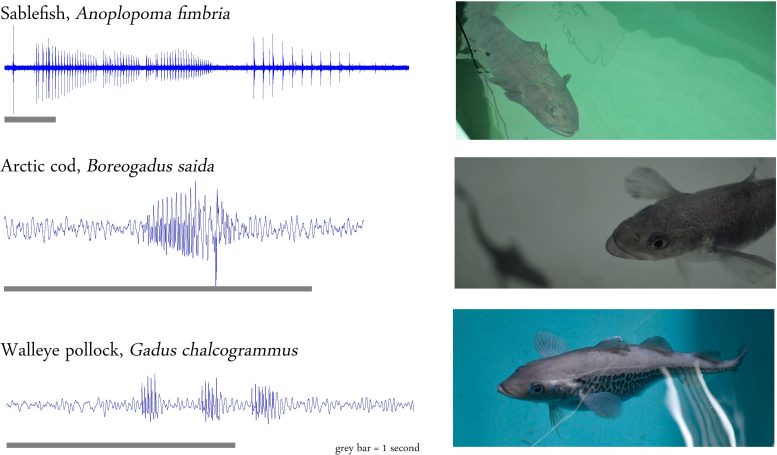
Waveform visualizations of sound production of three species described by one of the project collaborators, Amalis Riera, during the work of Riera et al., 2018 and Riera et al., 2020.
Scientists have developed an extensive inventory of underwater species known or suspected to produce sound. This groundbreaking work documents over 22,000 species, challenging the notion that aquatic life is predominantly silent and significantly advancing marine and aquatic sciences.
Scientists looking to uncover the mysteries of the underwater world have more valuable information at their fingertips thanks to an international team that has produced an inventory of species confirmed or expected to produce sound underwater.
Led by Audrey Looby from the University of Florida Department of Fisheries and Aquatic Sciences, the Global Library of Underwater Biological Sounds working group collaborated with the World Register of Marine Species to document 729 aquatic mammals, other tetrapods, fishes, and invertebrates that produce active or passive sounds. In addition, the inventory includes another 21,911 species that are considered to likely produce sounds.
Video of red drum (Sciaenops ocellatus; named for their characteristic drumming sounds produced during reproductive behavior) in the Discovery Room of the Nature Coast Biological Station.
With more than 70% of the Earth’s surface covered in water, most of the planet’s habitats are aquatic, and there is a misconception that most aquatic organisms are silent. The newly published comprehensive digital database on what animals are known to make sounds is the first of its kind and can revolutionize marine and aquatic science, the researchers said.
Video of fish auditioning in a tank environment. Credit: Amalis Riera
“Eavesdropping on underwater sounds can reveal a plethora of information about the species that produce them and is useful for a variety of applications, ranging from fisheries management, invasive species detection, improved restoration outcomes, and assessing human environmental impacts,” said Looby, who also co-created FishSounds, which offers a comprehensive, global inventory of fish sound production research.
A nest-building Plainfin Midshipman filmed by Mackenzie Woods while conducting her thesis research in Washington.
The team’s research, “Global Inventory of Species Categorized by Known Underwater Sonifery,” will be published today (December 18) in the journal Scientific Data and involved 19 authors from six countries, funding from the Richard Lounsbery Foundation and centuries of scientific effort to document underwater sounds.
A nest-building Plainfin Midshipman filmed by Mackenzie Woods while conducting her thesis research in Washington.
“Understanding how marine species interact with their environments is of global importance, and this data being freely available is a major step toward that goal,” said Kieran Cox, a member of the research team and a National Science and Engineering Research Council of Canada fellow.
Video with sounds of Amazon River Dolphin, Inia geoffrensis, recorded in the Pacaya-Samiria National Reserve, Peru during the work of Rountree et al. 2022.
Most people are familiar with whale or dolphin sounds but are often surprised to learn that many fishes and invertebrates use sounds to communicate, too, Looby said.
“Our dataset helps demonstrate how widespread underwater sound production really is across a variety of animals, but also that we still have a lot to learn,” she said.
Reference: “Global inventory of species categorized by known underwater sonifery” by Audrey Looby, Christine Erbe, Santiago Bravo, Kieran Cox, Hailey L. Davies, Lucia Di Iorio, Youenn Jézéquel, Francis Juanes, Charles W. Martin, T. Aran Mooney, Craig Radford, Laura K. Reynolds, Aaron N. Rice, Amalis Riera, Rodney Rountree, Brittnie Spriel, Jenni Stanley, Sarah Vela and Miles J. G. Parsons, 18 December 2023, Scientific Data.
DOI: 10.1038/s41597-023-02745-4









Be the first to comment on "Unlocking Aquatic Mysteries: Global Inventory Maps Underwater Sound Production"